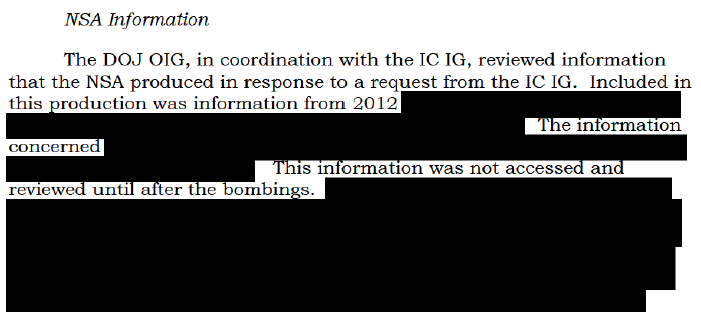The Government Uses the Dragnets for Detainee Proceedings
In the middle of a discussion of how the NSA let FBI, CIA, and NCTC directly access the database of Internet query results in the report accompanying the Internet dragnet End-to-End report, a footnote describes searches NSA’s litigation support team conducts. (See page 12)
In addition to the above practices, NSA’s litigation support team conducts prudential searches in response to requests from Department of Justice or Department of Defense personnel in connection with criminal or detainee proceedings. The team does not perform queries of the PR/TT metadata. This practice of sharing information derived from PR/TT metadata was later specifically authorized. See Primary Order, Docket Number PR/TT [redacted] at 12-13. The Government respectfully submits that NSA’s historic practice of sharing of U.S. person identifying information in this manner before it was specifically authorized does not constitute non-compliance with the PR/TT Orders.
Keith Alexander’s declaration accompanying the E2E adds more detail. (See page 16)
The designated approving official does not make a determination to release information in response to requests by Department of Justice or Department of Defense personnel in connection with criminal or detainee proceedings. In the case of such requests, NSA’s Litigation Support Team conducts prudential, specific searches of databases that contain both previously disseminated reporting and related analyst notes. The team does not perform queries of the PR/TT metadata. NSA then provides that research to Department of Justice or Department of Defense personnel for their review in connection with criminal or detainee proceedings. This practice of sharing information derived from the PR/TT metadata is now specifically authorized. See Primary Order, Docket Number PR/TT [redacted] at 12-13.
Language approving searches of the corporate store conducted on behalf of DOJ and DOD does not appear (at least not at 12-13) in the early 2009 — probably March 2, 2009 — Internet dragnet primary order. But related language was included in the September 3, 2009 phone dragnet order (it does not appear in the July 8, 2009 phone dragnet order, so that appears to have been the first approval for it). Given the timing, the language might stem either from another notice of violation to the FISC (one the government has redacted thus far); or, it might be a response to recommendations made in the Joint IG Report on the illegal dragnet, which was released July 10, 2009, and which did discuss discovery problems.
But the language describing the Litigation Support Team searches is far less descriptive in the September 3, 2009 phone dragnet order.
Notwithstanding the above requirements, NSA may share information derived from the BR metadata, including U.S. person identifying information, with Executive Branch personnel in order to enable them to determine whether the information contains exculpatory or impeachment information or is otherwise discoverable in legal proceedings.
The E2E and Alexander’s declaration make two things more clear.
First, NSA can disseminate this information without declaring the information is related to counterterrorism (that’s the primary dissemination limitation discussed in this section), and of course, without masking US person information. That would at least permit the possibility this data gets used for non-counterterrorism purposes, but only when it should least be permitted to, for criminal prosecutions of Americans!
Remember, too, the government has explicitly said it uses the phone dragnet to identify potential informants. Having non-counterterrorism data available to coerce cooperation would make that easier.
The E2E and Alexander declaration also reveal that the Litigation Support Team conducts these searches not just for DOJ, but also for DOD on detainee matters.
That troubles me.
According to the NYT’s timeline, only 20 detainees arrived at Gitmo after these dragnets got started, and 14 of those were High Value Detainees who had been stashed elsewhere for years (as were the last batch arrived in 2004). None of the men still detained at Gitmo, at least, had been communicating with anyone outside of very closely monitored situations for years. None of the Internet dragnet data could capture them (because no historical data gets collected). And what phone data might include them — and remember, the phone dragnet was only supposed to include calls with one end in the US — would be very dated.
So what would DOD be using these dragnets for?
Perhaps the detainees in question weren’t Gitmo detainees but Bagram detainees. Plenty of them had been out communicating more recently in 2004 and 2006 and even 2009, and their conversations might have been picked up on an Internet dragnet (though I find it unlikely any were making phone calls to the US).
It’s possible the dragnet was used, in part, to track released detainees. Is dragnet contact chaining one of the things that goes into claims about “recidivist” detainees?
Finally, a more troubling possibility is that detainee attorneys’ contacts with possible witnesses got tracked. Is it possible, for example, that DOD tracked attorneys’ contacts with detainee family members in places like Yemen? Given allegations the government spied on detainees’ lawyers, that’s certainly plausible. Moreover, since NSA does not minimize contacts between attorneys and their client until the client has been indicted, and so few of the Gitmo detainees have been charged, it would be utterly consistent to use the dragnet to track lawyers’ efforts to defend Gitmo detainees. Have the dragnets been focused on attorneys all this time?
One thing is clear. There is not a single known case where DOJ or DOD have used the dragnets to provide exculpatory information to someone; Dzhokhar Tsarnaev was unable to obtain discovery on dragnet information even after the government bragged about using the dragnet in his case.
Nevertheless, NSA has been sharing US person information without even having to attest it is counterterrorism related, outside of all the minimization procedures the government boasts about.

